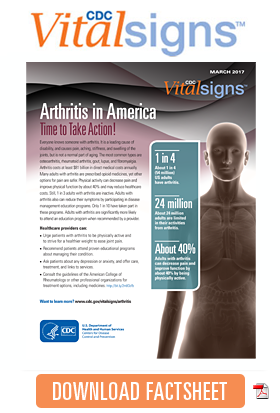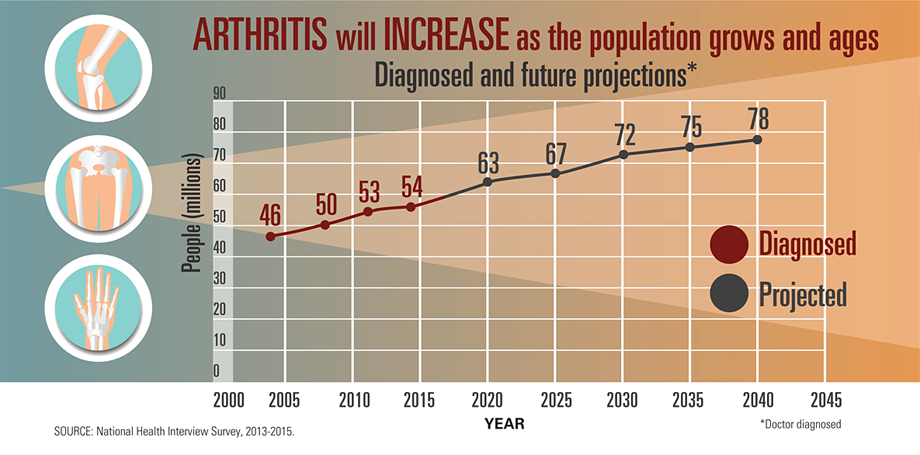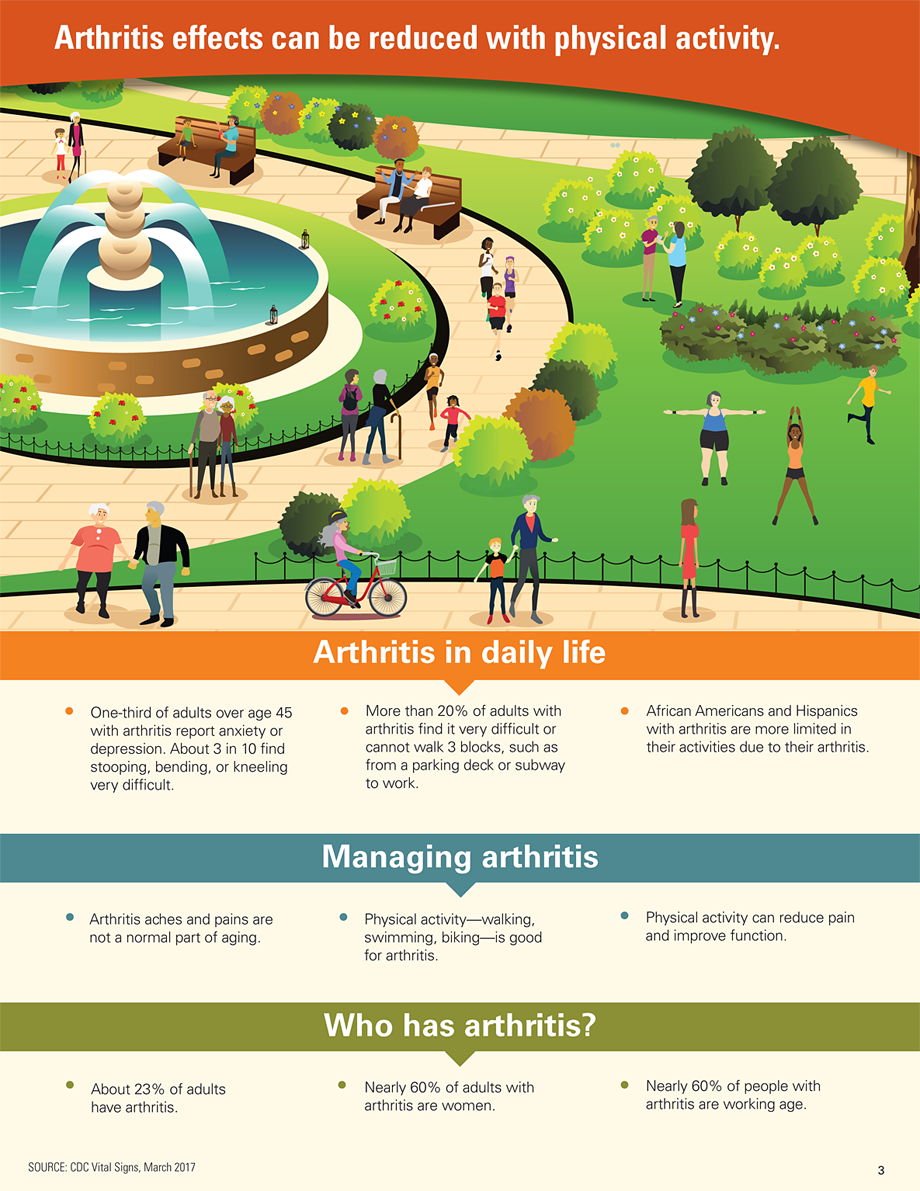Vital Signs: Arthritis in America
Time to Take Action!
Everyone knows someone with arthritis. It is a leading cause of disability, and causes pain, aching, stiffness, and swelling of the joints, but is not a normal part of aging. The most common types are osteoarthritis, rheumatoid arthritis, gout, lupus, and fibromyalgia. Arthritis costs at least $81 billion in direct medical costs annually. Many adults with arthritis are prescribed opioid medicines, yet other options for pain are safer. Physical activity can decrease pain and improve physical function by about 40% and may reduce healthcare costs. Still, 1 in 3 adults with arthritis are inactive. Adults with arthritis also can reduce their symptoms by participating in disease management education programs. Only 1 in 10 have taken part in these programs. Adults with arthritis are significantly more likely to attend an education program when recommended by a provider.
Healthcare providers can:
- Urge patients with arthritis to be physically active and to strive for a healthier weight to ease joint pain.
- Recommend patients attend proven educational programs about managing their condition.
- Ask patients about any depression or anxiety, and offer care, treatment, and links to services.
- Consult the guidelines of the American College of Rheumatology or other professional organizations for treatment options, including medicines. http://bit.ly/2m8Ocfb

About 1 in 4 (54 million) US adults have arthritis.
About 24 million adults are limited in their activities from arthritis.
Adults with arthritis can decrease pain and improve function by about 40% by being physically active.
Arthritis is common and a growing health threat.
Arthritis is common in adults.
- About 1 in 4 (54 million) adults have arthritis.
- More than half of adults with arthritis (32 million) are of working age (18-64 years).
Arthritis is disabling.
- The percent of adults limited by arthritis has increased by about 20% since 2002. The everyday activities of 24 million adults are limited by it, such as holding a cup, lifting a grocery bag, or walking to a car.
- More than 1 in 4 adults with arthritis report severe joint pain.
- Adults with arthritis are more than twice as likely as adults without arthritis to report an injury related to a fall.
- Working-age adults with arthritis have lower employment than those without arthritis.
Arthritis makes it harder to manage heart disease, diabetes or obesity.
- About half of adults with heart disease (49%) or diabetes (47%) have arthritis, as do one-third (31%) of those who are obese.
- About half the adults with arthritis who also have heart disease, diabetes or obesity, have some limitation of their normal activities because of their arthritis.
- Physical activity helps manage all these conditions.
- Increased pain, fear of pain, and lack of knowledge of safe forms of physical activity can make it harder for people with arthritis to be physically active.
Physical activity programs can reduce yearly healthcare costs by about $1,000 per person.
The Federal government is
- Supporting national organizations and programs at local parks and recreation areas, community and senior centers, healthcare facilities, and YMCAs to help adults better manage their arthritis.
- Supporting proven physical activity and educational programs through state health departments, health and human service agencies, and community organizations.
- Funding home and community-based services that help people with arthritis and other chronic diseases maintain and improve their health and independence.
- Providing toolkits and resource materials for organizations delivering community-based physical activity and educational programs for those with chronic diseases.
- Providing courses, guidance, and decision-making tools to primary care physicians to support patients’ ability to manage their own condition.
- Collecting data on arthritis in the US and conducting prevention and biomedical research to guide public health activities related to arthritis.
Healthcare providers can
- Urge patients with arthritis to be physically active and to strive for a healthier weight to ease joint pain.
- Recommend patients attend proven educational programs about managing their condition.
- Ask patients about any depression or anxiety, and offer care, treatment, and links to services.
- Consult the guidelines of the American College of Rheumatology or other professional organizations for treatment options, including medicines. http://bit.ly/2m8Ocfb.
Adults with arthritis can
- Learn proven actions to deal with pain, fatigue, anxiety and depression.
- Be physically active (like walking, swimming, or biking) to help maintain and improve strength, flexibility, and endurance.
- Adopt healthy eating habits and lose weight, if necessary.
- Attend educational programs to gain confidence and skills on managing arthritis.
- Use medications correctly under a healthcare provider’s care.
State officials and community leaders can
- Promote physical activity and disease management educational programs to adults with arthritis through public health departments, parks and recreation agencies, and community and senior centers.
- Support improvements for more walkable community areas to increase opportunities for physical activity.
- Create a system for healthcare providers and adults with arthritis to locate community-based programs.
- Conduct communications campaigns to promote physical activity or educational programs.
Issue Details
- Vital Signs Issue details: Arthritis, Morbidity and Mortality Weekly Report (MMWR)
- Vital Signs – Arthritis [PODCAST – 1:15 minutes]
- Vital Signs – Arthritis [PSA – 0:60 seconds]
- CDC: Arthritis
- CDC: State-Specific 2015 BRFSS Prevalence Estimates
- CDC: Arthritis Frequently Asked Questions (FAQs)
- CDC: Arthritis Intervention Programs
- CDC: Arthritis—Data and Statistics



